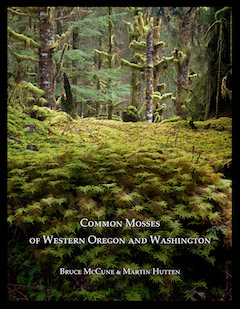Common Mosses of Western Oregon and Washington
Last Updated on November 21, 2022 by

by Bruce McCune and Martin Hutten
ISBN: 978-0-9987108-2-2
Wild Blueberry Media, Corvallis, Oregon, U.S.A., 2018
Geared towards beginning moss enthusiasts, this luxuriantly illustrated guide to “one of the mossiest places in the world” is a great place to start for bryo-curious botanists in the Pacific Northwest. The volume is perfect for the field or lab, as it includes field-observable and microscopic photographs on nearly every page and, at only 146 pages long, it easily fits in one’s backpack. The authors are both scientists who specialize on bryophytes and lichens. The first author, Bruce McCune, is a professor at Oregon State University where he has taught for over 20 years and published extensive scientific research and identification guides on lichens and bryophytes. The second author, Martin Hutten, currently works for USDA Forest Service in Alaska, and has worked for National Forests and National Parks throughout North America. Martin earned a PhD in 2014 from Oregon State University where he conducted research on lichens in Yosemite National Park. The two authors combine their wealth of knowledge on bryophytes with exceptional photography to write a book that is accessible for beginners wanting to dive into the world of mosses. I was particularly interested in writing this review for two reasons. First, I am a lichenologist who recently started to learn bryophyte identification. Second, I teach undergraduate botany at a university and was curious to see if this book would be a good educational aid.
The text is organized into three main sections: introductory material, extensive keys, and further information including a glossary and references. The introductory material begins by outlining the scope and purpose of the book and unique features of the keys. A detailed review of moss basic biology and life cycles follows with illustrations and bolded key vocabulary. The section wraps up with instructions on how to collect, preserve, and study mosses in the lab. Next, the keys comprise the bulk of the book (110 of 148 pages). The structure of the keys in this book is unique when compared to similar references. The distinguishing features for each couplet is listed first and demarcated by a semicolon. Then, descriptions are listed after the semicolon, and full illustrations are integrated onto the page where the species is listed. This layout reduces the amount of flipping back and forth between keys, descriptions, and illustrations that is inevitable in the layout of most similar books. Illustrations in the key section are extensive. The right page of each two-page spread is all photographs, and the left page is a quarter to half photographs as well. For instance, if you collected a sample of Claopodium you would be directed to “Key O – Pleurocarps; Costa Long and Single; Papillose Leaves.” On this two-page spread, in addition to extensive discussion on the differences among the three species, on the left, you will find a photograph illustrating differences among the leaves of the three species and, on the right, macroscopic photographs of the three species, along with a micrograph of the diagnostic papillae of Claopodium crispifolium. After the keys, there is a short nomenclatural note on synonyms, a page illustrating the evolutionary relationships among moss genera, and my favorite part of the back material—a thoroughly illustrated glossary. Most terms are illustrated with high quality photographs, and a full-page line drawing of leaf shapes is included as well. Acknowledgements, references, and an index wrap up the very end of the book. This content is encompassed in an easy-to-pack paperback book with all glossy paper.
Common Mosses of Western Oregon and Washington is a great starting point for botanists interested in expanding their knowledge to moss identification from northern California to British Columbia. I also recommend it for educators who incorporate moss identification into their teaching, as I know of no better beginner’s reference.
– Jessica Allen, PhD – Assistant Professor, Eastern Washington University
